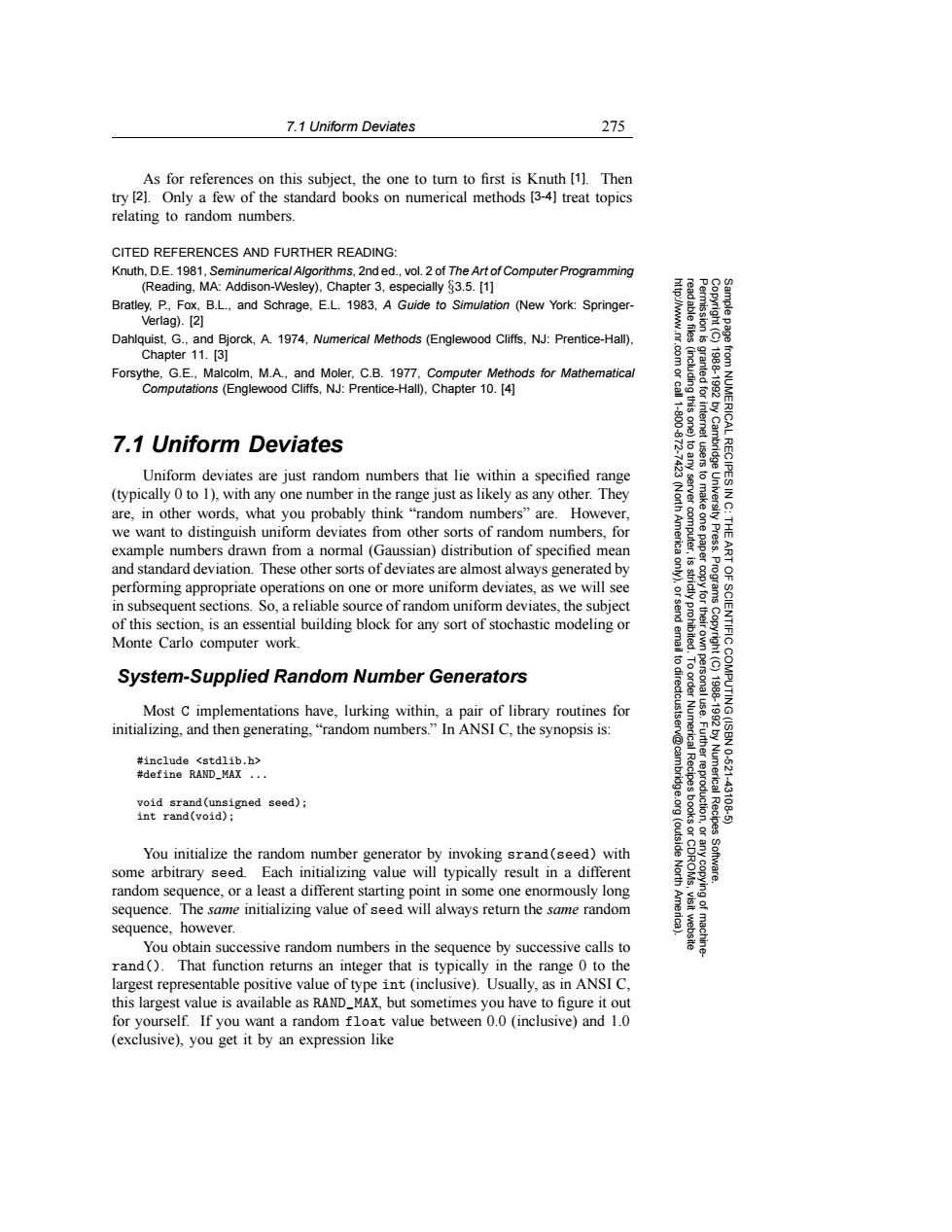正在加载图片...

7.1 Uniform Deviates 275 As for references on this subject,the one to turn to first is Knuth [1].Then try [2].Only a few of the standard books on numerical methods [3-4]treat topics relating to random numbers. CITED REFERENCES AND FURTHER READING: Knuth,D.E.1981,Seminumerical Algorithms,2nd ed..vol.2 of The Art of Computer Programming (Reading.MA:Addison-Wesley),Chapter 3,especially $3.5.[1] Bratley.P..Fox.B.L..and Schrage,E.L.1983.A Guide to Simulation (New York:Springer- Verlag).[2] Dahlquist,G.,and Bjorck,A.1974,Numerica/Methods (Englewood Cliffs,NJ:Prentice-Hall). Chapter 11.[3] Forsythe,G.E.,Malcolm,M.A.,and Moler,C.B.1977,Computer Methods for Mathematical Computations(Englewood Cliffs,NJ:Prentice-Hall),Chapter 10.[4] 7.1 Uniform Deviates Uniform deviates are just random numbers that lie within a specified range (typically 0 to 1),with any one number in the range just as likely as any other.They are,in other words,what you probably think "random numbers"are.However, we want to distinguish uniform deviates from other sorts of random numbers,for example numbers drawn from a normal(Gaussian)distribution of specified mean and standard deviation.These other sorts of deviates are almost always generated by performing appropriate operations on one or more uniform deviates,as we will see Programs in subsequent sections.So,a reliable source of random uniform deviates,the subject of this section,is an essential building block for any sort of stochastic modeling or OF SCIENTIFIC Monte Carlo computer work. 61 System-Supplied Random Number Generators Most C implementations have,lurking within,a pair of library routines for initializing,and then generating,"random numbers."In ANSI C,the synopsis is: #include <stdlib.h> #define RAND_MAX... void srand(unsigned seed); Numerical Recipes 10621 43106 int rand(void); You initialize the random number generator by invoking srand(seed)with (outside some arbitrary seed.Each initializing value will typically result in a different North Software. random sequence,or a least a different starting point in some one enormously long sequence.The same initializing value of seed will always return the same random sequence,however. You obtain successive random numbers in the sequence by successive calls to rand().That function returns an integer that is typically in the range 0 to the largest representable positive value of type int (inclusive).Usually,as in ANSIC, this largest value is available as RAND_MAX,but sometimes you have to figure it out for yourself.If you want a random float value between 0.0 (inclusive)and 1.0 (exclusive),you get it by an expression like7.1 Uniform Deviates 275 Permission is granted for internet users to make one paper copy for their own personal use. Further reproduction, or any copyin Copyright (C) 1988-1992 by Cambridge University Press. Programs Copyright (C) 1988-1992 by Numerical Recipes Software. Sample page from NUMERICAL RECIPES IN C: THE ART OF SCIENTIFIC COMPUTING (ISBN 0-521-43108-5) g of machinereadable files (including this one) to any server computer, is strictly prohibited. To order Numerical Recipes books or CDROMs, visit website http://www.nr.com or call 1-800-872-7423 (North America only), or send email to directcustserv@cambridge.org (outside North America). As for references on this subject, the one to turn to first is Knuth [1]. Then try [2]. Only a few of the standard books on numerical methods [3-4] treat topics relating to random numbers. CITED REFERENCES AND FURTHER READING: Knuth, D.E. 1981, Seminumerical Algorithms, 2nd ed., vol. 2 of The Art of Computer Programming (Reading, MA: Addison-Wesley), Chapter 3, especially §3.5. [1] Bratley, P., Fox, B.L., and Schrage, E.L. 1983, A Guide to Simulation (New York: SpringerVerlag). [2] Dahlquist, G., and Bjorck, A. 1974, Numerical Methods (Englewood Cliffs, NJ: Prentice-Hall), Chapter 11. [3] Forsythe, G.E., Malcolm, M.A., and Moler, C.B. 1977, Computer Methods for Mathematical Computations (Englewood Cliffs, NJ: Prentice-Hall), Chapter 10. [4] 7.1 Uniform Deviates Uniform deviates are just random numbers that lie within a specified range (typically 0 to 1), with any one number in the range just as likely as any other. They are, in other words, what you probably think “random numbers” are. However, we want to distinguish uniform deviates from other sorts of random numbers, for example numbers drawn from a normal (Gaussian) distribution of specified mean and standard deviation. These other sorts of deviates are almost always generated by performing appropriate operations on one or more uniform deviates, as we will see in subsequent sections. So, a reliable source of random uniform deviates, the subject of this section, is an essential building block for any sort of stochastic modeling or Monte Carlo computer work. System-Supplied Random Number Generators Most C implementations have, lurking within, a pair of library routines for initializing, and then generating, “random numbers.” In ANSI C, the synopsis is: #include <stdlib.h> #define RAND_MAX ... void srand(unsigned seed); int rand(void); You initialize the random number generator by invoking srand(seed) with some arbitrary seed. Each initializing value will typically result in a different random sequence, or a least a different starting point in some one enormously long sequence. The same initializing value of seed will always return the same random sequence, however. You obtain successive random numbers in the sequence by successive calls to rand(). That function returns an integer that is typically in the range 0 to the largest representable positive value of type int (inclusive). Usually, as in ANSI C, this largest value is available as RAND_MAX, but sometimes you have to figure it out for yourself. If you want a random float value between 0.0 (inclusive) and 1.0 (exclusive), you get it by an expression like